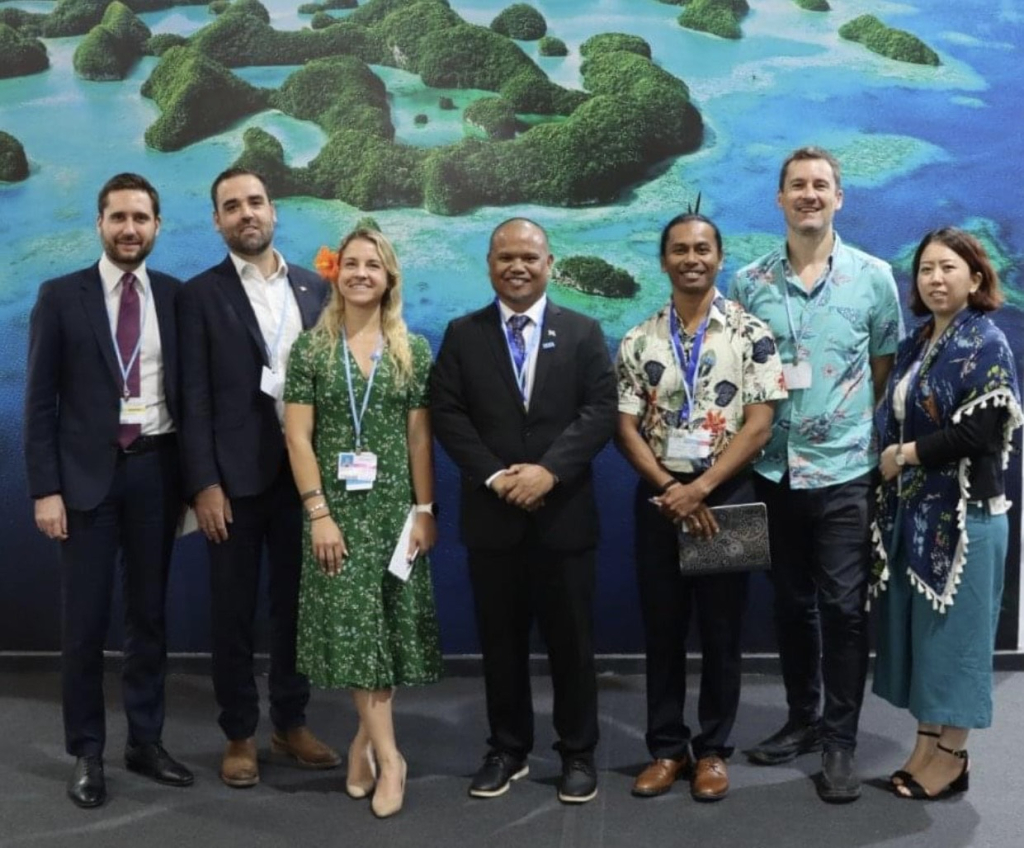
11 November 2022, Sharm El-Sheikh - At COP27 in Sharm El Sheikh, Egypt, Pacific Government leaders and officials along with representatives of the private sector, shared their experiences on carbon markets and how they can be used to deliver emission reductions while maintaining environmental integrity.
The talanoa, organised by the Government of Palau, on behalf of Pacific Small Island Developing States (PSIDS), was held at the Moana Blue Pacific Pavilion at the Sharm el-Sheikh International Convention Centre.
Article 6 of the UNFCCC process is critical to the issue of carbon markets. It clarifies how international carbon markets should function, essentially to support the transfer of emission reductions between countries while also incentivising the private sector to invest in climate-friendly solutions. The article also provides guidance on how countries can cooperate to generate cheaper — and deeper — greenhouse gas reductions through carbon markets, allowing for more ambitious Nationally Determined Contributions (NDCs).
Speaking during the side event, Palau’s Minister of Agriculture, Fisheries and Environment, Hon. Steven Victor, said estimates have placed the potential savings from a globally integrated carbon market, under Article 6, as high as hundreds of billions of dollars every year.
This money, he said, could be funnelled into additional emission reductions, further raising ambition and providing support for adaptation.
“Many see carbon markets as key to channelling billions of dollars into reducing emissions. In 2021, the value of carbon credits traded on the voluntary market, for instance, exceeded US$1 billion, more than double the value in 2020. It is expected that this figure will grow exponentially in the coming years,” Hon. Victor said.
“Moreover, the markets are driving energy transition and enabling nature-based solutions that contribute towards our aim of limiting global warming to 1.5 degrees Celsius and building resilience.”
Hon. Victor continued that Article 6 could also provide a means of incorporating climate commitments by the private sector into the UNFCCC process and improve trading arrangements to ensure that environmental integrity is prioritised.
“Significantly, the operation of Article 6 can be a source of climate finance for mitigation and adaptation in developing nations, while helping to contribute to their sustainable development efforts,” he said. “As players in this space the onus is on us to ensure that the rules governing markets are further refined to focus on improved oversight and accountability, so as to foster trust and confidence in markets as a viable means to deliver global emissions reductions.”
This side event provided the opportunity for participants to share their market and non-market approaches on emission reduction targets, as well as looking at ways where Pacific countries can benefit from the financial incentives.

The Question and Answer session facilitated by the Secretariat of the Pacific Regional Environment Programme’s (SPREP) Climate Change Adviser, Mr Tim Breese, featured Mr Xavier Matsutaro, National Climate Change Coordinator, Office of Climate Change - Palau, Mr Daniel Lund, Special Advisor, Climate Action – Fiji, Ms Jacqui Ruesga, Senior Analyst ETS Markets, Ministry for the Environment - New Zealand, Mr Maiko Ugo, Section Chief, Office of Director for International Cooperation for Transition to Decarbonization and Sustainable Infrastructure - Japan and Mr Andrea Bonzanni, International Policy Director - International Emissions Trading Association (IETA).
Speaking about Fiji’s experience, Mr Daniel Lund said the issue continues to evolve and there are a number of moving parts which negotiators must be on top of in order for Pacific nations to benefit.
“When Fiji started ten years ago, it was a very different landscape,” he said. “We were looking at markets from the perspective of reducing deforestation and its drivers,which are often linked to climate change. We have communities that when hit by a cyclone event, find themselves with limited resources. To deal with the damages and costs they incur, one of the first places they go is the forest. They engage in logging to create new income, so there is a linkage between the drivers of this vulnerability and climate change as well as the further pressures of extraction on the environment.”
He then explained “you need to look at pricing as an incentive to reduce pressures on the environment. Now we are looking at the broader scope of nature-based solutions as well as the ability to use markets as a means for additional financing for energy transition.”
He continued “ultimately carbon sequestration is an additional benefit to activities, such as restoring forests or marine ecosystems, that already have a huge range of disaster risk reduction and socio-economic benefits in Pacific Island countries,” said the Fiji delegate. The carbon reduction benefit can be a further incentive to be able to drive financing towards those activities.”
“In saying that, the integrity of these markets is incredibly important and Fiji has developed a very robust legal framework through its Climate Change Act to basically manage the way these markets will work in the future as well as the demand.”
The side event was among a number of activities Pacific delegates at COP27 are using to amplify their voice for a 1.5 to stay alive outcome in Sharma El-Sheikh, where more than 55,000 delegates have converged for the annual meeting.
The 27th Conference of the Parties to the UN Framework Convention on Climate Change (UNFCCC COP27) is being held in Sharm el-Sheikh, Egypt from 6 to 18 November 2022.
It is being attended by Pacific leaders and their delegations, who are advocating for their survival. The Secretariat of the Pacific Regional Environment Programme (SPREP) is lead of the One CROP, working together to provide support to Pacific Islands.